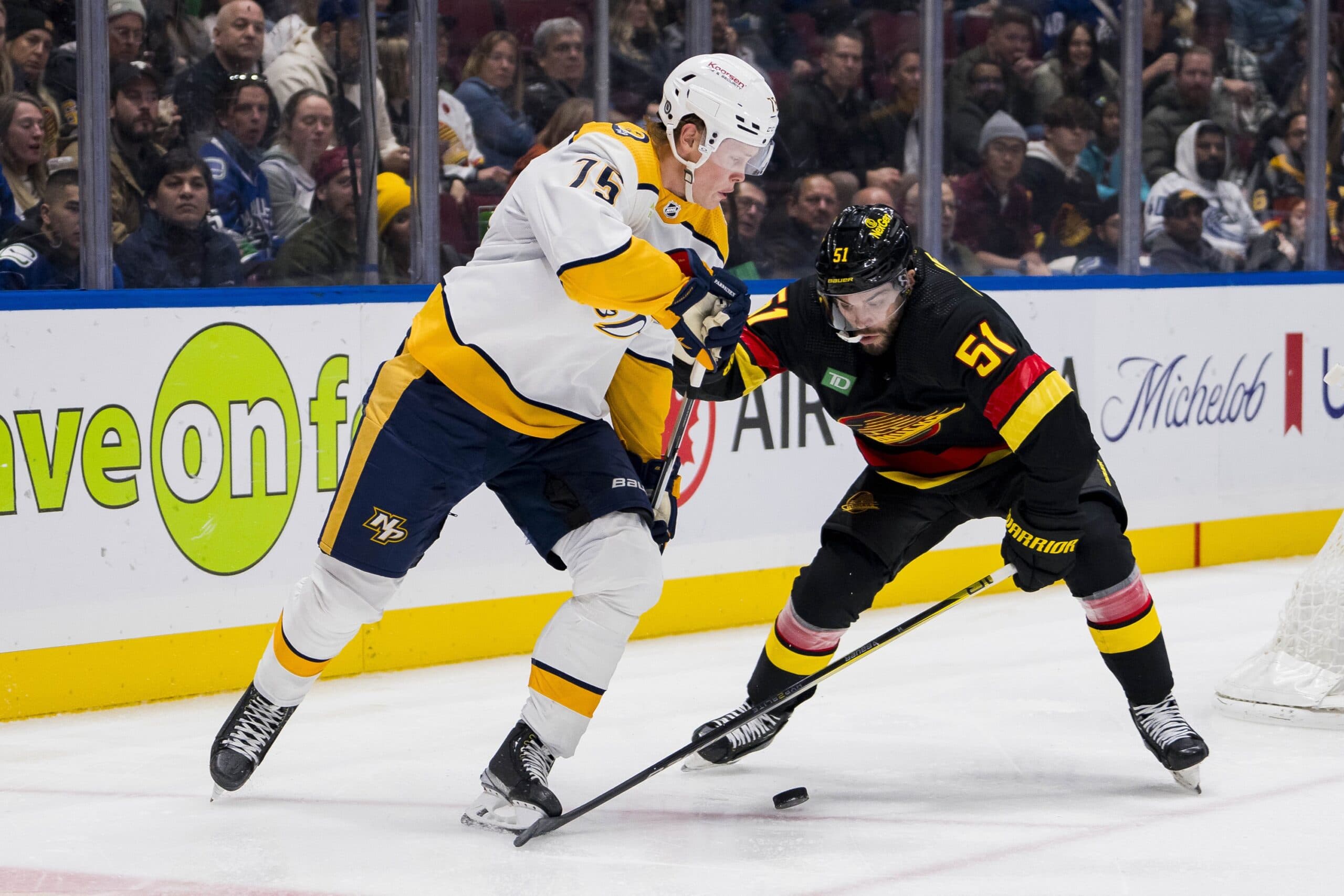Nation Sites
The Nation Network
CanucksArmy has no direct affiliation to the Vancouver Canucks, Canucks Sports & Entertainment, NHL, or NHLPA
The odds and benefits of the Canucks going with a shortened roster to accrue more cap space

Photo credit: © Bob Frid-Imagn Images
Sep 8, 2024, 09:00 EDTUpdated: Sep 8, 2024, 12:30 EDT
Jim Rutherford made his desires quite clear in a sit-down with The Province earlier this week.
“What we want to do is start the season without someone on LTIR,” Rutherford said.
There’s not much ambiguity in the statement. But fans of the Vancouver Canucks in particular know all too well that wants don’t always translate into actual occurrences. All of which raises a question of whether the Canucks starting the season without at least one player on long-term injured reserve is even possible – and what benefits they might reap from pulling it off.
The Typical 23-Player Roster
Due to being one of the teams that travels the most miles in an NHL season, the Canucks have almost always carried a full roster of 23 players whenever possible. And they’ve almost always stuck with the mix of 13 forwards, eight defenders, and two goalies.
Were they to do so in 2024/25, they’re already set up to come in under the cap without the need for any LTIR.
The 13 forwards can be penciled in as Elias Pettersson ($11.6 million), JT Miller ($8 mil), Brock Boeser ($6.65 mil), Jake DeBrusk ($5.5 mil), Conor Garand ($4.95 mil), Dakota Joshua ($3.25 mil), Danton Heinen ($2.25 mil), Teddy Blueger ($1.8 mil), Pius Suter ($1.6 mil), Kiefer Sherwood ($1.5 mil), Nils Höglander ($1.1 mil), Daniel Sprong ($975K), and Nils Åman ($825K).
The eight defenders can be penciled in as Quinn Hughes ($7.85 mil), Filip Hronek ($7.25 mil), Carson Soucy ($3.25 mil), Tyler Myers ($3 mil), Vincent Desharnais ($2 mil), Derek Forbort ($1.5 mil), Noah Juulsen ($775K), and Mark Friedman ($775K).
The two goalies – for now, anyway, and more on that in a moment – would be Thatcher Demko ($5 mil) and Arturs Silovs ($850K).
On top of that total, we need to factor in the dead cap of Oliver Ekman-Larsson’s buyout ($2.35 mil this season) and Ilya Mikheyev’s retained salary ($713K).
And then, if the Canucks’ goal is to avoid placing anyone on LTIR, they also need to add and accommodate Tucker Poolman’s full $2.5 million cap hit on top of it all, with Poolman presumably heading to regular IR.
Tabulate all that, and you wind up with a total cap hit of $87,809,167, which is just $190,833 below the cap.
There may be some wiggling on the exact details of a 23-player roster. Maybe Phil di Giuseppe makes it instead of Åman, or maybe a younger defender steals the spot of Juulsen or Friedman. In any case, the numbers will shake out to about the same.
Technically-speaking, such a roster would meet Rutherford’s stated desire of not using LTIR relief space to start the season, which in turn allows the Canucks to slowly but surely accrue daily cap space.
Should that $190,833 cushion be maintained throughout the entirety of the season – a virtual impossibility – the result of accrual would be $845,117 of cap space by the 2025 Trade Deadline.
That’s enough to fit in a barely-above-minimum NHL contract. Or, looked at differently, a player making four times that much on double-retention.
That’s not nothing. If that’s all the Canucks end up with in terms of accrual, it’ll at least be a lot more than they’ve managed to glean in years past.
But when you hear that it is an organizational goal to stay out of LTIR and accrue cap space, you get the idea that Rutherford and Co. have more in mind than a few extra dollars.
In order to accrue more space, they’ll need to explore some more creative roster solutions.
But before we get to that topic, we need to address the elephant in the room.
With or Without Thatcher Demko
Demko’s uncertain status heading into Training Camp greatly complicates the situation.
If Demko is ready to start the season, then everything we’ve written still applies. If he’s not, more complex decisions will need to be made.
With a long enough injury, Demko could always go on LTIR, opening up a maximum of $5 million in relief spending until his return. But then that plainly counters the goal of starting the season without anyone on LTIR.
Alternatively, Demko goes on IR, which opens up his roster space but keeps his full cap hit on the books.
Under that scenario, a different goaltender would need to join Silovs on the roster. Maybe that’s the rumoured Kevin Lankinen, Antti Raanta, or Martin Jones. Or maybe it’s just third-stringer Jiri Patera.
In any case, the salary should be in the same ballpark, so we can use Patera as a placeholder. His $775,000 cap hit is quite literally the minimum salary, but it’s still not going to fit into that scant $109,833 the Canucks currently have on hand.
To place Demko (and Poolman) on IR, and to then fit another goalie under the cap, the Canucks would need to start the regular season with a shortened roster.
Take the lowest-ranking member of the depth chart out of the equation. From where we’re standing, that’s probably Friedman.
He goes on waivers, Patera gets his spot, and the cap space heading into the season remains exactly the same due to their identical hits. The only downside is that the Canucks start out with just one extra forward and one extra defender on the roster, which isn’t ideal, but it is workable.
Which leads one to wonder about the possibility and likelihood of the team running a shortened roster even after Demko makes his return, for the express purpose of accruing even more space.
Shortening the Roster to Accrue Additional Space
Let’s imagine a scenario in which Demko regains his health and rejoins the roster fairly early in the season. To keep the math simple, we’re going to suppose that he’s ready to go for Game 1. Of course, he can return later and the same basic principles will apply, there will just be fewer days of that daily accrual.
So, we take our roster outlined in the first section, but we then cut an additional player from it and bring it down to a 22-player roster. This time around, we’ll cut Juulsen, because we’re tired of picking on Friedman and their salaries are the same, anyway. Either way, $775K comes off the top.
That would leave the Canucks with a total cap hit of $87,034,167, which is $965,833 under the cap.
That might not sound like a lot, but it’s actually far more significant than the roughly $109,833 they’d have with a 23-player roster.
Cap space of $965,833 would be enough for the team to call up any one player at any time for the purposes of short-term injury coverage.
It’s also an amount that would balloon considerably due to daily cap accrual. A cushion of $965,833 on day one, if maintained throughout, becomes $4,277,260 at the 2025 Trade Deadline.
That’s enough to add a good player without retention, and enough to add essentially anyone in the league through double-retention.
In other words, it’s an amount that could make a genuine difference.
Are those potential benefits enough to convince the Canucks to start the season with a shortened roster? The Demko situation may take that decision out of their hands to begin with. But Demko will return eventually, and at that point the Canucks will still have the shortened roster option on the table – so long as they’ve successfully managed to avoid LTIR placements up to that point.
Sponsored by bet365
Breaking News
- How likely is Quinn Hughes to win a Stanley Cup with the Minnesota Wild?
- Canucks sign Max Sasson to two-year contract extension
- NHL Draft: Who sits at the top of the 2026 class if the Canucks pick there?
- 3 Canucks Stars of the Week: Quinn Hughes’ last dance
- The Farmies: Victor Mancini goes coast-to-coast, but Abbotsford Canucks fall short in overtime
